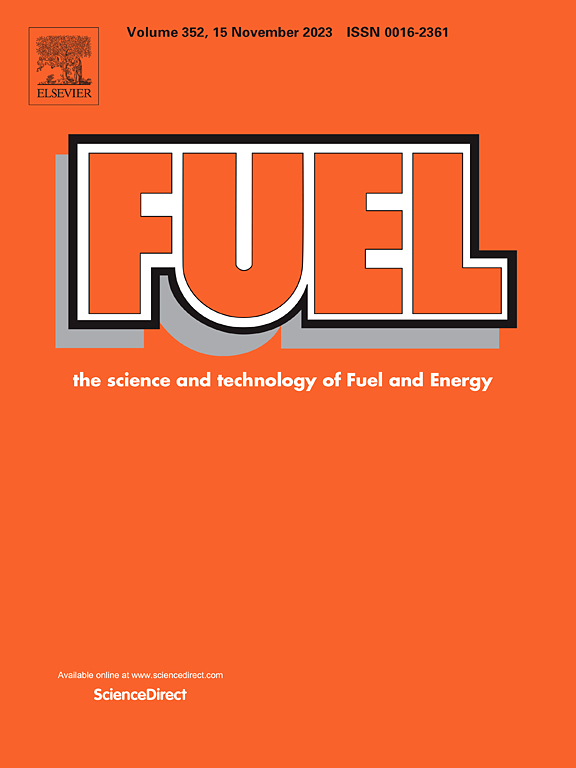氨硼制氢的分子动力学模拟:CO2和交变电场的双重促进
IF 6.7
1区 工程技术
Q2 ENERGY & FUELS
引用次数: 0
摘要
氨硼烷(AB)以其高储氢密度而闻名。本研究旨在探讨CO2气氛和电场(EF)对AB热解制氢机理的影响。通过反应力场分子动力学(ReaxFF-MD)模拟,得到了AB的主要产物、化学键的变化规律和详细的分解途径。首先,在没有EF的情况下,S3体系(AB/CO2摩尔比为2.89)的H2产率高于其他体系。比较不同的EF条件,发现当EF频率(νEF)为0.005 fs−1时,S3体系H2和H2O的产率最高。高频EF提高了反应速率,同时减少了副产物NH3的生成。AB的初始分解主要是BH和NH键的断裂,以及更多的分子间H转移。高频EF显著增强了AB的活化,促进了AB·NH3BH3→H2 + NH2BH2的热解脱氢是主要途径。当νEF大于0.001 fs−1时,该途径所占比例随着νEF的增大而逐渐减小。CO2的主要反应途径是加氢生成CO2H片段。最佳CO2比和EF存在时,S3体系的表观活化能为53.9 kJ/mol,低于S1(不含CO2和EF)的80.0 kJ/mol和S3(含CO2但不含EF)的68.6 kJ/mol。CO2与高频交变EF的耦合效应显著降低了AB热解脱氢的反应能垒。利用CO2和EF的共同作用,提高了H2的产率和质量。这种方法不仅实现了高效的氢转化,而且有助于碳中和。本文章由计算机程序翻译,如有差异,请以英文原文为准。

Molecular dynamics simulations of hydrogen production from ammonia borane: Dual promotion by CO2 and alternating electric field
Ammonia borane (AB) is known for its high hydrogen storage density. This study aims to investigate the effects of CO2 atmosphere and electric field (EF) on the mechanism of hydrogen production from AB pyrolysis. The variations of the main products, chemical bonds and the detailed decomposition pathways of AB were obtained from the reactive force field molecular dynamics (ReaxFF-MD) simulations. First, under no EF, the H2 yield in S3 system (AB/CO2 molar ratio of 2.89) is higher than that of other systems. Comparing different EF conditions, it is found that S3 system has the highest yield of H2 and H2O when the EF frequency (νEF) is 0.005 fs−1. The high-frequency EF increases the reaction rate while reducing the formation of the by-product NH3. The initial decomposition of AB is dominated by the cleavage of B![]() H and N
H and N![]() H bonds, as well as more intermolecular H transfer. The high-frequency EF significantly enhanced the activation of AB and promoted the pyrolysis dehydrogenation of AB·NH3BH3 → H2 + NH2BH2 is the dominant pathway. When the value of νEF exceeds 0.001 fs−1, the proportion of this pathway gradually decreases with increasing νEF. The main reaction pathway of CO2 is hydrogenation to generate CO2H fragments. The apparent activation energy of S3 system in the presence of optimal CO2 ratio and EF is 53.9 kJ/mol, which is lower than 80.0 kJ/mol of S1 (without CO2 and EF) and 68.6 kJ/mol of S3 (with CO2 but without EF). The coupling effect of CO2 and high-frequency alternating EF significantly reduces the reaction energy barrier of AB pyrolysis dehydrogenation. By leveraging the combined effects of CO2 and EF, both the yield and quality of H2 are improved. This approach not only achieves efficient hydrogen conversion but also contributes to carbon neutrality.
H bonds, as well as more intermolecular H transfer. The high-frequency EF significantly enhanced the activation of AB and promoted the pyrolysis dehydrogenation of AB·NH3BH3 → H2 + NH2BH2 is the dominant pathway. When the value of νEF exceeds 0.001 fs−1, the proportion of this pathway gradually decreases with increasing νEF. The main reaction pathway of CO2 is hydrogenation to generate CO2H fragments. The apparent activation energy of S3 system in the presence of optimal CO2 ratio and EF is 53.9 kJ/mol, which is lower than 80.0 kJ/mol of S1 (without CO2 and EF) and 68.6 kJ/mol of S3 (with CO2 but without EF). The coupling effect of CO2 and high-frequency alternating EF significantly reduces the reaction energy barrier of AB pyrolysis dehydrogenation. By leveraging the combined effects of CO2 and EF, both the yield and quality of H2 are improved. This approach not only achieves efficient hydrogen conversion but also contributes to carbon neutrality.
求助全文
通过发布文献求助,成功后即可免费获取论文全文。
去求助
来源期刊

Fuel
工程技术-工程:化工
CiteScore
12.80
自引率
20.30%
发文量
3506
审稿时长
64 days
期刊介绍:
The exploration of energy sources remains a critical matter of study. For the past nine decades, fuel has consistently held the forefront in primary research efforts within the field of energy science. This area of investigation encompasses a wide range of subjects, with a particular emphasis on emerging concerns like environmental factors and pollution.
 求助内容:
求助内容: 应助结果提醒方式:
应助结果提醒方式:


